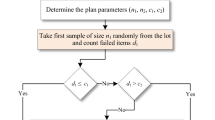Abstract
In this paper we introduce the generalized inverse Weibull finite failure software reliability model which includes both increasing and decreasing nature of the hazard function. The increasing/decreasing behaviour of the failure occurrence rate fault is taken into account by the hazard of generalized inverse Weibull distribution. The model parameters are estimated using maximum likelihood method for interval domain data and numerical examples are provided to illustrate the estimation technique. The proposed model is compared with the standard existing models through error sum of squares, mean sum of squares, predictive ratio risk and Akaikes information criteria using different data sets. The result showed that the proposed model performs satisfactorily better than the existing finite failure category models.





Similar content being viewed by others
References
Calabria R, Pulcini G (1990) On the maximum likelihood and least squares estimation in the inverse Weibull distributions. Stat Appl 2(1):53–66
De Gusmao FRS, Ortega EMM, Cordeiro GM (2011) The generalized inverse Weibull distribution. Stat Pap 3(52):519–619
Drapella A (1993) Complementary Weibull distribution: unknown or just forgotten. Qual Reliab Eng Int 9:383–385
Dumonceaux R, Antle CE (1973) Discrimination between the lognormal and Weibull distribution. Technometrics 15:923–926
Goel AL, Okumoto K (1979a) A Markovian model for reliability and other performance measures of software system. Proceedings of COMPCON (IEEE Computer Soceity Press, Los Angeles), pp 769–774
Goel AL (1985) Software reliability models: assumptions, limitations, and applicability. IEEE Trans Softw Eng 2(12):1411–1423
Goel AL, Okumoto K (1979b) Time dependent error-detection rate model for software reliability and other performance measures. IEEE Trans Reliab 28(3):206–211
Hjorth U (1980) A reliability distribution with increasing, decreasing, constant and bathtub-shaped failure rate. Technometrics 22:99–107
Jelinski Z, Moranda PB (1972) Software reliability research. In: Freiberger W (ed) Statistical computer performance evaluation. Academic Press, New York, pp 465–497
Jiang R, Murthy DNP (2001) Models involving two inverse Weibull distributions. Reliab Eng Syst Saf 1(73):73–81
Jiang R, Zuo MJ, Li HX (1999) Weibull and Weibull inverse mixture models allowing negative weights. Reliab Eng Syst Saf 66:227–234
Lyu MR (1996) Handb Softw Reliab Eng. McGraw-Hill, New York
Manjunatha KM, Harishchandra K (2011) Modeling and statistical inference on generalized inverse exponential software reliability growth model. Far East J Theor Stat 31(1):67–77
Maswadah M (2003) Conditional confidence interval estimation for the inverse Weibull distribution based on censored generalized order statistics. J Stat Comput Simul 72(12):887–898
Matsumoto Y, Ohno Y (1989) Japanese prespectives in software engineering. Addison-Wesley, Singapore
Moranda PB (1975) A comparison of software error rate models. In Proceedings of Texas conference on computing systems, IEEE Computer Society Press, Los Angeles
Mudholkar GS, Kollia GD (1994) Generalized Weibull family: a structural analysis. Commun Stat Theory Methods 23(4):1149–1171
Mudholkar GS, Srivastava DK, Kollia GD (1996) A generalization of the Weibull distribution with application to the analysis of survival data. J Am Stat Assoc 91:1575–1583
Murthy DNP, Xie M, Jiang R (2004) Weibull model. Wiley, New York
Musa JD, Lannino A, Okumoto K (1987) Software reliability: measurement, prediction and application. McGraw-Hill, New York
Musa JD, Okumoto K (1985) Applications of basic and logarithmic Poisson execution model in software reliability measure. Chall Adv Comput Technol Syst Des Methods, NATO Adv Stud Inst 34(1):68–100
Nelson WB (1982) Applied life data analysis. Wiley, New York
Ohba M, Yamada S (1984) S-shaped software reliability growth models. Proceedings of the 4th international conference reliability and maintainability, pp 430–436
Pham H (2006) System software reliability. Springer, New York
Schick GJ, Wolverton RW (1973) Assessment of software reliability. Proceedings in operations research, Wirzberg-Wien, Physica Verlag, pp 395–422
Schneidewind NF (1972) An approach to software reliability prediction and quality control, fall joint computer conference, AIFPS conference proceedings, 41. AFIPS press, Montvale, pp 837–847
Schneidewind NF (1975) Analysis of error processes in computer software. Proceedings of international conference on reliable software, IEEE Computer Soceity, pp 337–346
Van Pul MC (1992) Asymptotic properties of a class of statistical models in software reliability. Scand J Stat 19(3):235–253
Yamada S, Ohba M, Osaki S (1984) S-Shaped software reliability growth models and their applications. IEEE Trans Reliab 33:289–292
Zhang Y, Chen W, Sun S (2007) Improvement of the software reliability model with equivalent failure times. Proceedings of the 2007 WSEAS international conference on computer engineering and applications (pp 84–88). Gold Coast, 17–19 January 2007
Zhao M, Xie M (1996) On maximum likelihood estimation for a general non-homogeneous Poisson process. Scand J Stat 23(4):597–607
Author information
Authors and Affiliations
Corresponding author
Rights and permissions
About this article
Cite this article
Hanagal, D.D., Bhalerao, N.N. Modeling and Statistical Inference on Generalized Inverse Weibull Software Reliability Growth Model. J Indian Soc Probab Stat 17, 145–160 (2016). https://doi.org/10.1007/s41096-016-0010-8
Accepted:
Published:
Issue Date:
DOI: https://doi.org/10.1007/s41096-016-0010-8




